Origins & Organization of
Polish Troops
In Italian Campaign
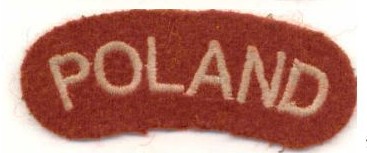
| MENU SELECTION: | The Italian Campaign | At The Front | Books | Armies | Maps | 85th Division | Websites |

This page provides general details of the organization of the Polish units that served with the British in Italy. The intent of my website limits a full review of all the units and organization during the entire period. Hopefully, this will explain their organization. An interesting aspect of the Polish units is that they were allowed to recruit replacement troops from Poles who had served in the German Army.
| The patch shown above was worn by Polish troops on their
British uniforms. |
British 8th Army Commanding Generals:
Gen Bernard "Monty" Montgomery commanded during Sicily and landings in Italy.
Lt.-Gen Sir Oliver Leese- 31 Dec 1943 - 1 Oct 1944.
Gen Sir Richard L. McCreery- from 1 Oct 1944 - end of war.
Polish Commanders: Lt..-General Wladyslaw Anders. He was also from the Russian PW camp.
Other commanders included:
Corps Deputy Commander – Lt. Gen Zygmunt Bohusz-Szyszko
Chief of Staff – Col. Kazimerz Wisniowski
3rd Division Commander – Maj-General Bronislaw Duch
1st Brigade Commander – Col. Walenty Peszek
2nd Brigade Commander – Col Roman Szymanski
5th Division Commander – Maj-General Nikodem Sulik
5th Brigade Commander – Col. Wincenty Kurek
6th Brigade Commander – Col. Witold Nowina-Sawicki
2nd Armoured Brigade Commander – Maj-General Bronislaw Rakowski
2nd Artillery Group Commander – Col. Ludwik Zabkowski
For other Nationalities, go to:
US &
Main Menu
British
Canadians French Brazilians
|
Polish Corps
The Polish
soliders traveled a long, hard road to get to the Italian
Campaign.
They demonstrated they were willing to fight the Germans in any
location
to get their country back. Poland was the first country
attacked
by Germany and their dubious ally, Russia. The Polish prisoners
were
placed in Russian camps. When the Germans turned against the
Russians,
the British convinced the Russians to release the Poles so they could
help
fight their common enemy. The Polish troops were outfitted by the
British and sent to the 8th Army. Strength of Polish Corps (Upon arrival in Italy in July 1943)Reference: "Poles in the Italian Campaign" by Olgierd Terlecki, Printed in Warsaw in 1972.
|
| II Polish Corps -
Lt.-Gen. W. Anders 5th Kresowa Infantry Division - Maj.-Gen Sulik Artillery - Col. J. Orski 5 Wilenska Field Regiment 5 Kresowa Anti-Tank Regiment 5 Kresowa Light Anti-Tank Regiment 7 Polish Horse Artillery Regiment 23 Field Regiment Engineers - 4 Kresowa Field Company 5 Kresowa Field Company 6 Kresowa Field Company 5 Kresowa Field Park Company 5 Kresowa Machine Gun Battalion 25 Wielkopolski Recon Regiment 2nd Polish Armored Brigade - Maj-Gen D. Rakowski 1 Polish Armored Cavalry Regiment 4 Polish Armored Regiment 6 Lwowski Armored Regiment 9 Polish Field Troop (Engineers) 4th Wolynska Infantry Brigade - Lt. Col W. Stoczkowski 10 Wolynska Rifle Battalion 11 Wolynska Rifle Battalion 12 Wolynska Rifle Battalion 5th Wilenska Infantry Brigade - Col. Kurek 13 Wilenska Rifle Battalion 14 Wilenska Rifle Battalion 15 Wilenska Rifle Battalion 6th Lwowski Infantry Brigade - Col. Sawicki 16 Lwowski Rifle Battalion 17 Lwowski Rifle Battalion 18 Lwowski Rifle Battalion II Polish Corps Support Artillery - Maj. Gen R. Odierzynski 1 Polish Survey Regiment 7 Polish Anti-Tank Regiment 663 Polish Air OP Squadron * 567 Searchlight Battery 8 Polish Heavy Anti-Aircraft Artillery Army Group Polish Artillery - Col. K. Zabkowski 10 Polish Medium Regiment (5.5 inch) 11 Polish Medium Regiment (4.5 inch) 12 Polish Medium Regiment (4.5 inch) 13 Polish Medium Regiment (5.5 inch) 78 Medium Regiment (5.5 inch) 9 Polish Heavy Regiment (Mixed) II Polish Corps Engineers - Col. J. Sochocki 4 Carpathian Rifle Battalion 5 Carpathian Rifle Battalion 6 Carpathian Rifle Battalion 3rd Carpathian Rifle Brigade - Lt.-Col G. Lowezowski 7 Carpathian Rifle Battalion 8 Carpathian Rifle Battalion 9 Carpathian Rifle Battalion ----------------------------------------------------------------------------- * No. 663 Artillery Observation Squadron flew as artillery observers over German positions after January 1945. They operated slow observation aircraft and lead bombers to their targets on 258 bombing missions. Reference: "15th Army Group History; 16 December 1944- 2 May 1945" by Battery Press. |
| Casualties Organization of the Polish Corps in earl Monte Cassino - 24th April - 31st May, 1944 -- Total = 3,948 KIA 923 WIA 2,931 MIA 94 Anacona on Adriatic Coast - 15 June - 25th July, 1944 -- Total = 2,434 KIA 496 WIA 1,789 MIA 139 Spring Offensive 1945 - April 1945 -- Total = 1,480 KIA 249 WIA 1,219 MIA 12 Reference: "Poles in the Italian Campaign" by Olgierd Terlecki, Printed in Warsaw in 1972. |
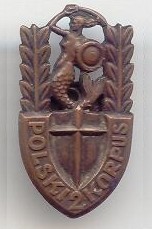 2nd Army Corps |
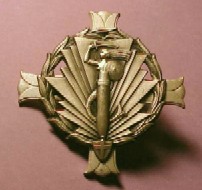 2nd Artillery Group of 2nd Corps |
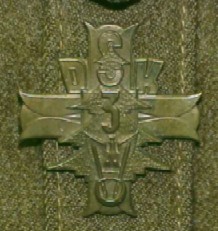 3rd Carparthian Infantry Division attached to breast pocket |
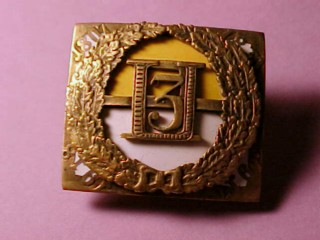 3rd Sileisan Lancer Regiment
|
This is included just case you find a few Polish words in your research. Some of the unit badges are identified with
these words or their abbreviation.
Dywizji = Division
Korpus = Corps
Putk = Regiment
Brygudy = Brigade
Grupa = Group
Batilion = Battalion
Szwadron = Squadron
Kompania = Company
Strzelcow = Rifle
Piechoty = Infantry
Pancerna = Armor
Ulanow = Lancers
Saperow = Engineers
Zandarmeria = Military Police
Laczwosci = Signals
Komej = Horse
Artylerii = Artillery
Zdrowia = Medical
Materialowa = Ordnance (material)
Georgraficzna = Geographic
Sprawiedliwosci = Legal
Examples of Compound TermsDywizji Strzelcow == Rifle Division
Sayerow Kolejowych == Railway Engineer
Warsztatowo-Naprawcza == Electrical/Mechanical
Komandosow Zmotoryzowanpch == Motorized Commando
Artylerii Przeciwpnancerej == Anti-Tank Artillery
Artylerii Przeciwlotniczej Lekkiej == Light Anti-Aircraft Artillery
Artylerii Przeciwlotniczej Ciezkiej == Mediuim Anti-Aircraft Artillery
Go to US Divisions - Regiments & Supporting Units, for a complete list of US Divisions and the Regiments with illustration of shoulder patch for each.Go To:
US Units
Canadians French Polish Brazilians
German
| MENU SELECTION: | The Italian Campaign | At The Front | Books | Armies | Maps | 85th Division | Websites |